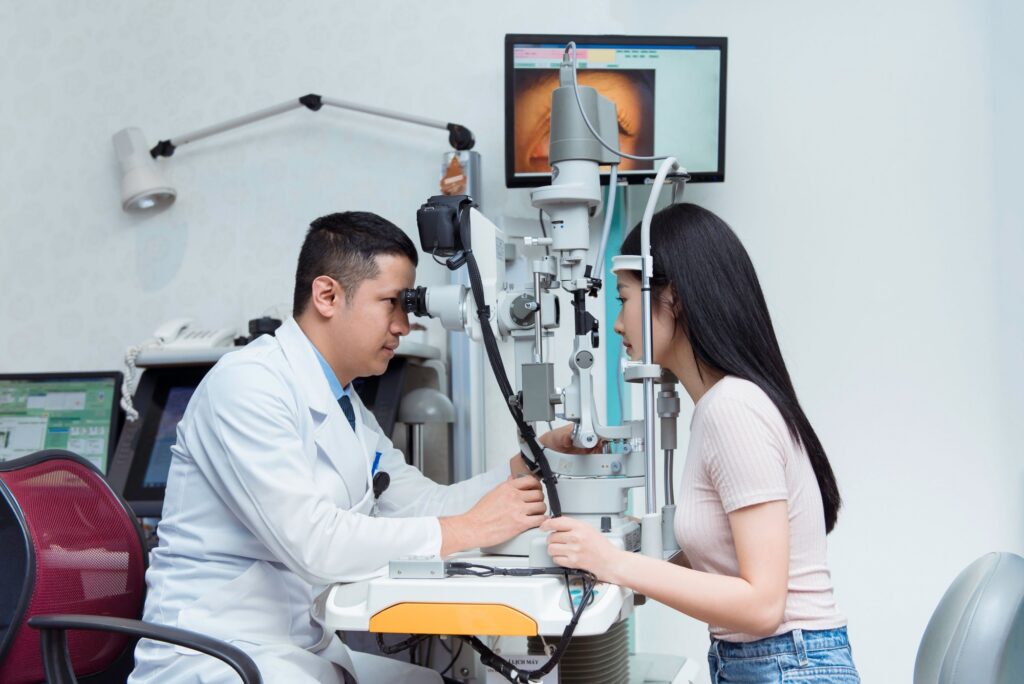Intravitreal injections have become a common treatment approach for various retinal conditions. Understanding the purpose of these injections and the benefits they offer is essential for patients and healthcare providers alike. This article aims to explore the world of intravitreal injections, from their definition and procedure to their role in treating specific retinal conditions. We will also discuss the risks and benefits associated with these injections, how to prepare for them, and what the future holds for this treatment approach.
Understanding Intravitreal Injections
Before delving into the specifics, let’s first define what intravitreal injections are and why they are used. Intravitreal injections involve the direct injection of medication into the vitreous gel, which fills the space between the lens and the retina in the eye. The purpose of this injection is to deliver medication precisely to the target area, bypassing other ocular barriers.
When considering the intricacies of intravitreal injections, it’s essential to understand the significance of this targeted approach. By directly administering medication into the vitreous gel, healthcare providers can achieve higher concentrations of the drug at the site of action, maximizing therapeutic effects while minimizing systemic side effects. This precision is particularly crucial in the treatment of retinal diseases where localized therapy is paramount for optimal outcomes.
Definition and Purpose of Intravitreal Injections
Intravitreal injections are used to treat various retinal conditions, including age-related macular degeneration (AMD), diabetic retinopathy, and retinal vein occlusion. These injections allow for the delivery of medications such as anti-vascular endothelial growth factor (anti-VEGF) agents or corticosteroids directly to the affected area.
Moreover, the evolution of intravitreal injections has revolutionized the management of retinal diseases, offering patients improved visual outcomes and disease stabilization. The advent of anti-VEGF therapy, in particular, has transformed the treatment landscape, providing a non-invasive yet highly effective option for conditions like neovascular AMD.

The Procedure: What to Expect
If you’re scheduled to undergo an intravitreal injection, it’s natural to have questions about the procedure. Rest assured that it is a relatively simple and minimally invasive process. Before the injection, your eye will be numbed with local anesthesia, ensuring minimal discomfort during the procedure. Your healthcare provider will then use a fine needle to carefully inject the medication into the vitreous gel. The entire process usually takes only a few minutes. Read more about local anesthesia on https://medicine.uiowa.edu/iowaprotocols/maximum-recommended-doses-and-duration-local-anesthetics
Following the injection, it is common to experience some mild discomfort or irritation, which typically subsides quickly. Your healthcare team will provide post-injection care instructions to ensure optimal healing and medication efficacy. It’s essential to follow these guidelines diligently to promote recovery and maximize the benefits of the intravitreal injection.
The Role of Intravitreal Injections in Retinal Treatment
Intravitreal injections play a crucial role in the treatment of various retinal conditions. Let’s explore some of the common conditions where this treatment approach has proven effective.
Retinal diseases encompass a wide range of conditions that can significantly impact vision and overall quality of life. The use of intravitreal injections, a minimally invasive procedure where medication is delivered directly into the vitreous cavity of the eye, has become a cornerstone in the management of these conditions. By targeting the specific site of pathology within the eye, intravitreal injections offer a targeted and potent treatment option with fewer systemic side effects compared to oral medications.
Treating Age-Related Macular Degeneration
Age-related macular degeneration is a leading cause of vision loss in older adults. Intravitreal injections of anti-VEGF agents have revolutionized the treatment of wet AMD. These injections help reduce abnormal blood vessel growth and slow down the progression of the disease, preserving visual function in many patients.
Wet AMD, characterized by the growth of abnormal blood vessels beneath the macula, can lead to rapid and severe vision loss if left untreated. Anti-VEGF agents, such as ranibizumab and aflibercept, work by inhibiting the activity of vascular endothelial growth factor (VEGF), a key player in the formation of these leaky blood vessels. The regular administration of intravitreal injections of these agents has been shown to not only stabilize vision but in some cases even improve visual acuity in patients with wet AMD.
Managing Diabetic Retinopathy
Diabetic retinopathy, a complication of diabetes, can lead to vision loss if left untreated. Intravitreal injections, again often utilizing anti-VEGF agents, have shown remarkable success in managing the condition. By reducing retinal swelling and preventing the growth of abnormal blood vessels, these injections help preserve vision and improve outcomes for diabetic retinopathy patients.
Diabetic retinopathy is a progressive disease that affects the blood vessels of the retina, leading to diabetic macular edema and proliferative diabetic retinopathy, both of which can result in severe vision impairment. The timely administration of intravitreal injections plays a crucial role in controlling the underlying inflammation and vascular changes associated with diabetic retinopathy, ultimately preserving the delicate structures of the retina and preventing irreversible vision loss. To read more about edema click here.
Addressing Retinal Vein Occlusion
Retinal vein occlusion occurs when a retinal vein becomes blocked, leading to a range of vision problems. Intravitreal injections, sometimes combined with corticosteroids, have shown efficacy in reducing macular edema and improving visual acuity in patients with retinal vein occlusion.
Retinal vein occlusion is a vascular disorder that can result in varying degrees of vision loss depending on the location and extent of the blockage. The use of intravitreal injections, particularly those containing anti-VEGF agents or corticosteroids, aims to reduce the macular edema and inflammation associated with retinal vein occlusion. By addressing the underlying vascular pathology and promoting the reabsorption of fluid in the macula, these injections can help improve visual outcomes and prevent further damage to the retinal tissue.
Risks and Benefits of Intravitreal Injections
Like any medical procedure, intravitreal injections come with both risks and benefits. It’s important for patients to be aware of these before undergoing treatment.
Before delving into the specifics of intravitreal injections, it’s crucial to understand the importance of maintaining regular follow-up appointments post-injection. These appointments allow healthcare providers to monitor your eye health, track progress, and address any concerns promptly. Open communication with your healthcare team is key to ensuring the best possible outcomes.
Potential Side Effects and Complications
While intravitreal injections are generally safe, there are potential side effects and complications to consider. These can include eye infections, increased intraocular pressure, floaters, and retinal detachment. However, it is crucial to note that these complications are rare, and the benefits of intravitreal injections often outweigh the risks.
Furthermore, it’s essential to recognize the role of pre-treatment evaluations in mitigating potential risks. Your healthcare provider will conduct thorough assessments to determine the most suitable course of action for your specific condition, ensuring personalized care and minimizing adverse effects.
Success Rates and Patient Outcomes
When it comes to success rates, intravitreal injections have shown remarkable efficacy in improving patient outcomes for various retinal conditions. Many patients experience significant improvements in visual acuity, reduced swelling, and slowed disease progression. Discussing the potential benefits with your healthcare provider will help you make an informed decision.
Moreover, understanding the post-injection care regimen is vital for optimizing treatment outcomes. Your healthcare provider will provide detailed instructions on post-injection care, including activity restrictions, medication management, and symptom monitoring. Adhering to these guidelines diligently can enhance the effectiveness of intravitreal injections and promote a smooth recovery process.
Preparing for Intravitreal Injections
Preparation plays a vital role in ensuring a smooth and successful intravitreal injection procedure. Let’s take a closer look at what you can expect during the pre-procedure stage and how to care for yourself afterward.
Before the actual intravitreal injection takes place, it’s important to understand the significance of the procedure. Intravitreal injections are commonly used to administer medications directly into the vitreous cavity of the eye. This targeted approach allows for the treatment of various eye conditions, such as macular degeneration, diabetic retinopathy, and retinal vein occlusion.

Pre-Procedure Consultation
Prior to your intravitreal injection, your healthcare provider will conduct a thorough consultation. This will involve discussing your medical history, current medications, and any concerns or questions you may have. It’s essential to be open and transparent during this consultation to ensure the best possible treatment plan for you.
During the pre-procedure consultation, your healthcare provider may also explain the potential risks and benefits associated with intravitreal injections. Understanding these aspects can help you make an informed decision about your eye care treatment and alleviate any concerns you may have about the procedure.
Post-Procedure Care and Recovery
After your intravitreal injection, it’s crucial to follow the post-procedure care guidelines provided by your healthcare provider. This may include avoiding strenuous activities, using eye drops as prescribed, and attending follow-up appointments. Adhering to these instructions will help facilitate a smooth recovery and optimize treatment outcomes.
Additionally, it’s common to experience some mild discomfort, redness, or temporary changes in vision after an intravitreal injection. These symptoms typically subside within a few days, but it’s important to report any persistent or worsening issues to your healthcare provider promptly.
Future of Intravitreal Injections
The field of intravitreal injections is constantly evolving, with ongoing technological advancements and promising research paving the way for the future of retinal treatment. Let’s explore some of the exciting developments in this area.
Technological Advancements and Research
New drug delivery systems, such as sustained-release implants and microneedles, are being developed to enhance the convenience and effectiveness of intravitreal injections. These advancements aim to address some of the challenges associated with frequent injections, such as patient discomfort and the need for repeated visits to the clinic. Sustained-release implants, for example, can provide a controlled release of medication over an extended period, reducing the frequency of injections and improving patient compliance.
Furthermore, researchers are exploring novel treatment approaches to expand the range of conditions that can be successfully managed with intravitreal injections. For instance, studies are underway to investigate the use of intravitreal injections for the treatment of inherited retinal diseases, which currently have limited therapeutic options. These advancements hold great promise for improving the lives of patients with rare and debilitating retinal conditions.
Alternative Treatments on the Horizon
While intravitreal injections have proven highly effective for many retinal conditions, researchers are continuously exploring alternative treatment options to further enhance patient outcomes. One area of interest is gene and cell therapies, which aim to address the underlying genetic causes of retinal diseases. These therapies involve introducing healthy genes or cells into the retina to replace or repair the faulty ones, offering the potential for long-term and even permanent treatment.
Additionally, neuroprotective agents are being investigated as a potential adjunct to intravitreal injections. These agents aim to protect the retinal cells from further damage and promote their survival, potentially improving the overall efficacy of the injections. Furthermore, personalized medicine approaches tailored to specific patient needs are also being explored, with the goal of optimizing treatment outcomes by considering individual genetic variations and other factors.
In conclusion, intravitreal injections have emerged as a common and highly effective treatment approach for various retinal conditions. Understanding the process, risks, and benefits is essential for patients considering this therapy. By playing a significant role in managing conditions such as AMD, diabetic retinopathy, and retinal vein occlusion, intravitreal injections have transformed the landscape of retinal treatment. However, the future holds even greater promise for further advancements in retinal treatment. With ongoing research and technological advancements, the future of intravitreal injections looks promising, offering hope for continued advancements in patient care and outcomes. As we continue to unravel the complexities of retinal diseases, the potential for personalized and targeted therapies brings us closer to a future where vision loss can be prevented or effectively managed.
Read more about on the role of Retinal Treatments in Age-Related Macular Degeneration

